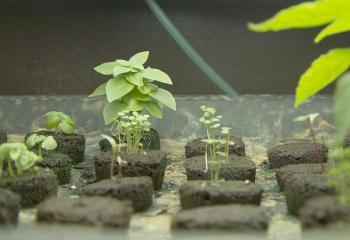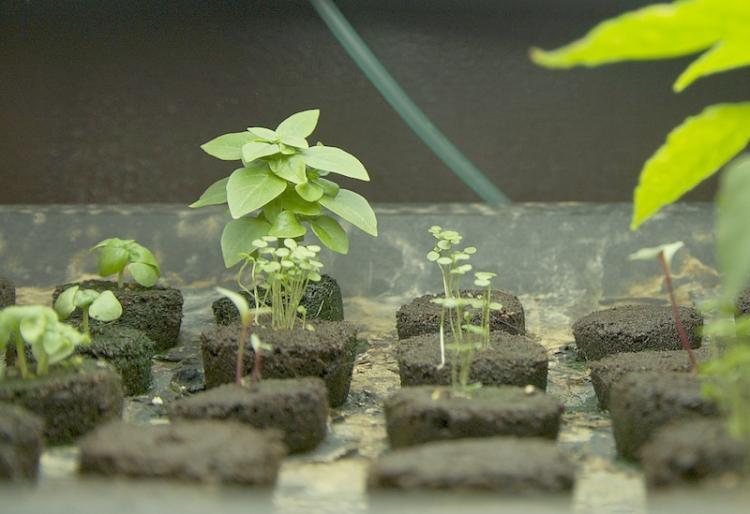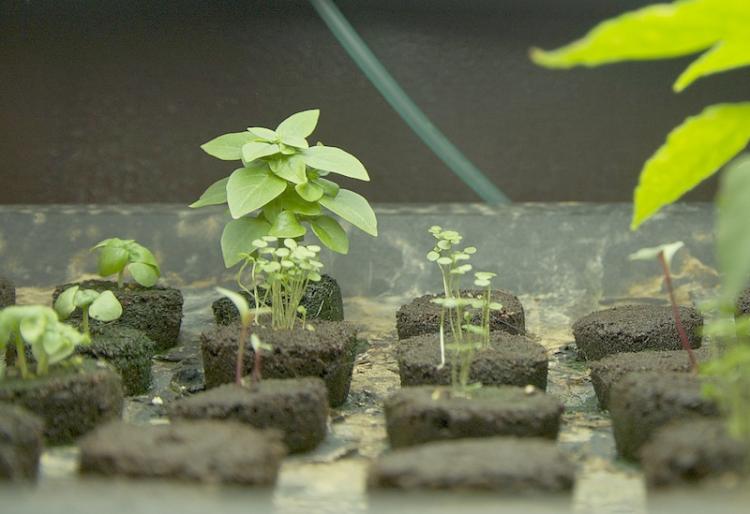NEW YORK—The low hum of water pumps greets visitors as they enter the main garden of Boswyck Farms, located in the Bushwick neighborhood of Brooklyn, in the sunny 1,000-square-foot, apartment of owner and founder Lee Mandell.
The pumps continuously circulate nutrient rich water over the roots of plants growing in five gallon buckets, PVC pipe, and other miscellaneous containers chosen or built by Mandell.
Hydroponics means growing plants in water, without soil.
“Most people think that soil is necessary to grow plants” said Mandell, who resembles a relaxed professor with bushy ringlets and small round, pink-colored glasses. The function of soil he said is to hold nutrients and keep the plants upright, “If we supply the nutrients directly to the roots and provide some sort of support for the plants, no soil is necessary,” he said.
Counterintuitively, hydroponics actually uses less water than traditional soil methods. This is because the water is re-circulated and none is lost to runoff. Hydroponics is also more space efficient, because plants can grow together more densely than in soil.
Indoors, Boswyck does not pay attention to climatic seasons; seasonal food is whatever is ready to pick. In the main grow area, Orange-red zebra tomatoes were ripening on vines held up by strings attached to the ceiling. The vine roots were submerged in five gallon buckets connected by PVC pipe to Rubbermaid storage bins, (reservoirs), holding the water pumped over to the plants.
Next to the tomatoes was a chocolate pepper plant bearing one brownish bell pepper. Bright lights shone on plants, and to maximize the amount of light, the grow area was enclosed in shiny silver reflective material, giving the garden a galactic feel, like the plants could be growing on a spaceship anywhere in the universe.
Mendell’s philosophy is that failure is important fact of life, whose value not taught today as it should be. Boswyck Farms is an example of successful experiment built from many failures. The strawberries growing in PVC pipe across from the peppers and tomatoes looked decidedly wilted if not dead. “This system is not doing all that well and I’m trying to figure out why,” said Mandell. He checked the hose that was supposed to be trickling water over the strawberries, found it clogged and gave the end a quick suck to start the water moving.
Boswyck vegetables are very flavorful, watercress from the farm had a real horseradish bite, the arugula was zippy and peppery, and one little habanero pepper had what seemed to be double the heat of a normal one.
Besides the initial start up cost of the growing containers and water pump, nutrients and seeds, the real cost of indoor Hydroponics comes from the electricity bill for the lights that shine 14 hours a day on some of the plants. The plants grown outside are of course much less expensive.
Boswyck Farms is a hydroponics research and development company. Mandell consults with private home growers, schools and churches and is working on educational curriculum covering science, engineering and nutrition through hydroponics gardening.
The farm was founded in 2008, and this year began experimenting with outdoor gardens, an endeavor marked by the failure of sugar snap peas and the unforeseen hazards of wind and rain. But other overall the garden appeared to be on track to produce a bountiful harvest of basil, plenty of tomatoes and a couple very tall sunflowers.
Hydroponics is not a new idea; the hanging gardens of ancient Babylon and the floating gardens of the Aztecs were hydroponic.
Today, hydroponics is a main method of commercial farming in arid Israel and about third of Holland’s tulips are grown with hydroponics.
The pumps continuously circulate nutrient rich water over the roots of plants growing in five gallon buckets, PVC pipe, and other miscellaneous containers chosen or built by Mandell.
Hydroponics means growing plants in water, without soil.
“Most people think that soil is necessary to grow plants” said Mandell, who resembles a relaxed professor with bushy ringlets and small round, pink-colored glasses. The function of soil he said is to hold nutrients and keep the plants upright, “If we supply the nutrients directly to the roots and provide some sort of support for the plants, no soil is necessary,” he said.
Counterintuitively, hydroponics actually uses less water than traditional soil methods. This is because the water is re-circulated and none is lost to runoff. Hydroponics is also more space efficient, because plants can grow together more densely than in soil.
Indoors, Boswyck does not pay attention to climatic seasons; seasonal food is whatever is ready to pick. In the main grow area, Orange-red zebra tomatoes were ripening on vines held up by strings attached to the ceiling. The vine roots were submerged in five gallon buckets connected by PVC pipe to Rubbermaid storage bins, (reservoirs), holding the water pumped over to the plants.
Next to the tomatoes was a chocolate pepper plant bearing one brownish bell pepper. Bright lights shone on plants, and to maximize the amount of light, the grow area was enclosed in shiny silver reflective material, giving the garden a galactic feel, like the plants could be growing on a spaceship anywhere in the universe.
Mendell’s philosophy is that failure is important fact of life, whose value not taught today as it should be. Boswyck Farms is an example of successful experiment built from many failures. The strawberries growing in PVC pipe across from the peppers and tomatoes looked decidedly wilted if not dead. “This system is not doing all that well and I’m trying to figure out why,” said Mandell. He checked the hose that was supposed to be trickling water over the strawberries, found it clogged and gave the end a quick suck to start the water moving.
Boswyck vegetables are very flavorful, watercress from the farm had a real horseradish bite, the arugula was zippy and peppery, and one little habanero pepper had what seemed to be double the heat of a normal one.
Besides the initial start up cost of the growing containers and water pump, nutrients and seeds, the real cost of indoor Hydroponics comes from the electricity bill for the lights that shine 14 hours a day on some of the plants. The plants grown outside are of course much less expensive.
Boswyck Farms is a hydroponics research and development company. Mandell consults with private home growers, schools and churches and is working on educational curriculum covering science, engineering and nutrition through hydroponics gardening.
The farm was founded in 2008, and this year began experimenting with outdoor gardens, an endeavor marked by the failure of sugar snap peas and the unforeseen hazards of wind and rain. But other overall the garden appeared to be on track to produce a bountiful harvest of basil, plenty of tomatoes and a couple very tall sunflowers.
Hydroponics is not a new idea; the hanging gardens of ancient Babylon and the floating gardens of the Aztecs were hydroponic.
Today, hydroponics is a main method of commercial farming in arid Israel and about third of Holland’s tulips are grown with hydroponics.


